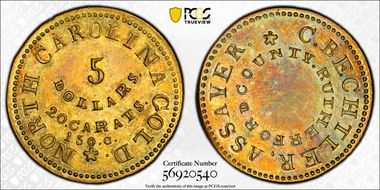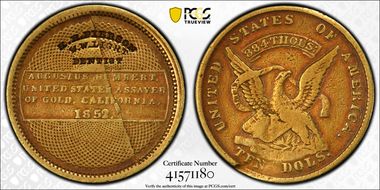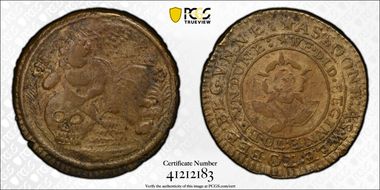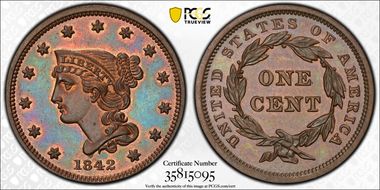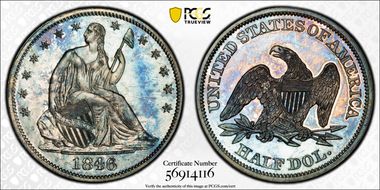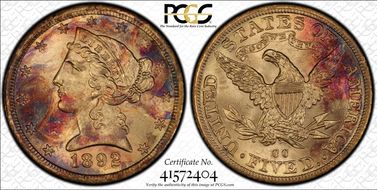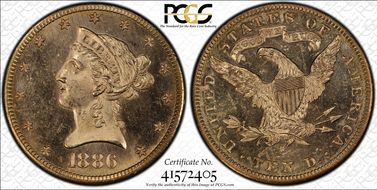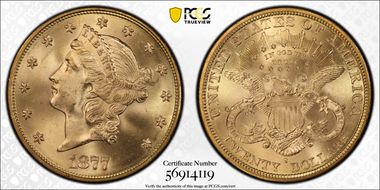Island of Misfit Toys 的展示图片库
The finest of somewhere between 12 and 15 examples in private hands. First sold publicly as a part of the Bushnell sale in 1882, the coin passed into legendary 19th century dealer Edouard Frossard’s collection, and was auctioned again in 1884. Eventually it passed to ANS President Andrew Zabriskie (Chapman, 1909), where it was purchased by Colonel James W. Ellsworth, and from there it passed to the legendary collection of John Work Garrett. In 1979, it was purchased by Don and Art Kagin, and resided in the Kagin Collection before passing into the collection of Christopher Allen. An absolutely incredible coin, and arguably the greatest Bechtler anywhere.
One of the first 46 coins struck from California gold — the Mormon $10s were produced and issued in mid-December, 1848, a couple of weeks before the 1848-dated CAL. Quarter Eagles. Things the finest of four graded Mormon $10s, and was owned by the famed collector “Colonel” E.H.R. Green in the early part of the 20th century. It then passed to legendary composer Jerome Kern, writer of such American standards as “Ol’ Man River”, “Smoke Gets in Your Eyes”, “A Fine Romance”, and “The Way You Look Tonight”. After Kern’s death in 1945, it was auctioned by B. Max Mehl, and passed into the collection of Amon Carter Sr. Following the death of Amon Carter Jr., it was sold by Stacks, and eventually found a place in the collection of Larry Miller, owner of the Utah Jazz. As the first coin struck from California gold, the Mormon $10 is among the most historically important pieces of Pioneer Gold. It is also incredibly rare, and has been absent from most of the greatest collections of Pioneer Gold Coins. The Green/Kern/Carter specimen is unquestionably the finest in private hands, boasting a full strike, choice luster, and fantastic original color.
Unique. An 1852/1 Humbert $10 counterstamped by H.H. Pierson and W.W. Light in Sacramento during the California gold rush. W.W. Light was a dentist, who also engraved dies for J.S. Ormsby's private gold coinage.
Unique. Cincinnati Mining & Trading Company is one of the great rarities of the entire Pioneer Gold series, with only THREE examples in private hands of any of the gold issues. The present example is unique as a uniface reverse die trial, and the finest of the three known $20 patterns. Essentially as made, with hints of red and copious die polish.
(c. 1584) The single finest Raleigh Plantations Token of either variety, boasting fresh, uncorroded surfaces, and a much better strike than is usually found on one of these. The design is one of my favorites, with a putti reclining on a stylized human skull, and bears a great legend: AS SOONE AS WEE TO BEE BEGVNNE, WE DID BEGINNE TO BE VNDONE. Enjoy the anomalous Elizabethan spelling...
Finest Known Small Planchet Pine Tree Shilling of any variety. While Small Planchet Pines are plentiful, there are well under ten known examples in mint state. I have owned both MS64s, and this is the example that I kept for my collection.
Unique. Discovered in the mid-19th century, this is the earliest pattern for a circulating U.S. coin. The obverse tests the hub used to create the Fugio obverse die, while the reverse is a test of the hub used to make the die for the rare American Congress pattern, which was the original reverse design for the Fugio, and was probably abandoned because of its complexity. An exceptionally important piece of Americana that is unknown to most collectors.
An exceptional early proof Large Cent that I purchased housed within a collector's box made for early 20th Century dentist and collector, Dr. French. Virtually as made, with plenty of red and beautiful oil-slick toning.
High Relief Lincoln Cent - One of two known white-metal 1942 experimental Lincoln Cents struck from an obverse die that measures 20% higher relief than the regular issue examples. Mint records suggest that these pieces were part of the process that eventually produced the "WAR SERIES" experimental dies. This is among the very last true patterns available to collectors.
Unique. Probably the single most dramatic error on an early U.S. gold coin. The present piece was in Art Kagin's collection before being sold to the great error specialist Henry Hilgard. Completely original and dripping with luster.
The only dramatic toner in the Saddle Ridge Hoard, and one of only a handful of Carson City coins in the group. Exceptionally clean for the assigned grade and super cool...
The only fully prooflike coin in the entire Saddle Ridge Hoard. Exceptionally well-struck and choice for the grade.
One of two or three known examples. Julius Popper was a Romanian-born adventurer who traveled to Argentina during the gold rush of the 1880s. He put together a band of mercenaries, called "Lavaderos del Oro del Sud" (Goldwashers of the South), and traveled to Tierra del Fuego, where he discovered gold. While camped at el Paramo, Popper struck one and five-gram gold coins from crudely made dies. These pieces are incredibly rare today, with only a handful known of each denomination. The present piece was struck on a very crude planchet, probably fashioned out of a placer nugget, this unrefined gold contains a fair amount of silver, which has toned dramatically in shades of blue, green and magenta. Essentially as made. Ex-Eliasberg.




















